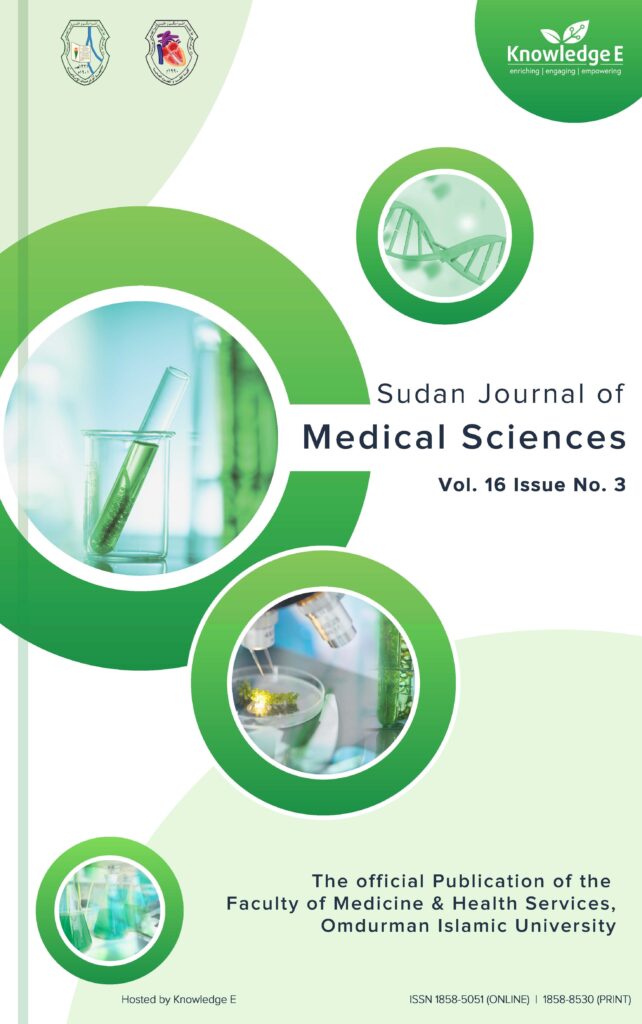
Sudan Journal of Medical Sciences
ISSN: 1858-5051
High-impact research on the latest developments in medicine and healthcare across MENA and Africa
Isolation, Extraction, and Characterization of Verotoxin-producing Escherichia coli O157:H7 from Diarrheal Stool Samples
Published date:Mar 31 2022
Journal Title: Sudan Journal of Medical Sciences
Issue title: Sudan JMS: Volume 17 (2022), Issue No. 1
Pages:116 - 127
Authors:
Abstract:
Background: Escherichia coli O157:H7 infection causes hemorrhagic colitis and is diagnosed based on symptoms such as cramps, stomach pain, and watery diarrhea. Shiga-like toxins (Verotoxin) produced by Escherichia coli O157:H7 damages endothelial cells of both kidney and brain, causing renal dysfunction and neurological problems.
Methods: The present study focuses on identifying the prevalence of Verotoxin-producing Escherichia coli O157:H7 among diarrheal inpatients at Erode Government Hospital, India, and its antibiogram. Further, the Verotoxins were characterized by using SDS-PAGE analysis. A total of 123 samples were collected both from diarrheal stools, and strains from 37 samples (43.02 %) were found to have the presence of E. coli. The organisms were identified based on their colony morphology on various media, cell morphology, and biochemical tests. The Shiga-like toxin production was identified by non-fermentation of sorbitol on SMAC agar plates. Confirmation of Shiga-like toxin was performed using agglutination assay.
Results: In total, 12 isolates showed agglutination and these isolates were confirmed to be E. coli O157:H7. The molecular weight of the Verotoxin was found to be between 20 and 29 kD. The antibiogram profile of the four isolated strains against 10 standard antibiotics was determined.
Conclusion: The results of this study show the occurrence of drug resistance on hemorrhagic colitis causing E. coli O157:H7.
Keywords: E. coli, Verotoxin, diarrhea, hemorrhagic colitis
References:
[1] Bryan, A., Youngster, I., and McAdam, A. J. (2015). Shiga toxin producing Escherichia coli. Clinics in Laboratory Medicine, vol. 35, no. 2, pp. 247–272.
[2] Nguyen, Y. and Sperandio, V. (2012). Enterohemorrhagic E. coli (EHEC) pathogenesis. Frontiers in Cellular and Infection Microbiology, vol. 2, no. 90, pp. 1–7.
[3] McWilliams, B. D. and Torres, A. G. (2014). Enterohemorrhagic Escherichia coli adhesins. Microbiology Spectrum, vol. 2, no. 3, pp. 1–19.
[4] Pang, B., Zhao, C., Li, L., et al. (2018). Development of a low-cost paper-based ELISA method for rapid Escherichia coli O157:H7 detection. Analytical Biochemistry, vol. 542, pp. 58–62.
[5] Zhou, S., Lu, C., Li, Y., et al. (2020). Gold nanobones enhanced ultrasensitive surface-enhanced raman scattering aptasensor for detecting Escherichia coli O157:H7. ACS Sensors, vol. 5, no. 2, pp. 588–596.
[6] Liu, Q., Chen, L., Laserna, A. K. C., et al. (2020). Synergistic action of electrolyzed water and mild heat for enhanced microbial inactivation of Escherichia coli O157:H7 revealed by metabolomics analysis. Food Control, vol. 110, p. 10726.
[7] Guo, M., Zhang, L., He, Q., et al. (2020). Synergistic antibacterial effects of ultrasound and thyme essential oils nanoemulsion against Escherichia coli O157:H7. Ultrasonics Sonochemistry, vol. 66, p. 104988.
[8] Cui, H., Zhang, C., Li, C., et al. (2020). Inhibition of Escherichia coli O157:H7 biofilm on vegetable surface by solid liposomes of clove oil. LWT, vol. 117, p. 108656.
[9] Stromberg, Z. R., Lewis, G. L., Marx, D. B., et al. (2015). Comparison of enrichment broths for supporting growth of Shiga toxin-producing Escherichia coli. Current Microbiology, vol. 71, no. 2, pp. 214–219.
[10] Pai, C. H., Gordon, R., Sims, H. V., et al. (1984). Sporadic cases of hemorrhagic colitis associated with E. coli O157:H7. Clinical, epidemiologic and bacteriologic features. Annals of Internal Medicine, vol. 101, pp. 738–742.
[11] Kongmuang, U., Honda, T., and Miwatani, T. (1987). Enzyme-linked immunosorbent assay to detect shiga toxin of Shigella dysenteriae and related toxins. Journal of Clinical Microbiology, vol. 25, no. 1, pp. 115–118.
[12] Griffin, P. M., Ostroff, S. M., Taxure R. V., et al. (1988). Illness associated with Escherichia coli O 157:H7 infections. Annals of Internal Medicine, vol. 109, pp. 705–712.
[13] Duc, H. M., Son, H. M., Yi, H. P. S., et al. (2020). Isolation, characterization and application of a polyvalent phage capable of controlling Salmonella and Escherichia coli O157:H7 in different food matrices. Food Research International, vol. 131, p. 108977.
[14] Etcheverria, A. I. and Padola, N. L. (2013). Shiga toxin-producing Escherichia coli: factors involved in virulence and cattle colonization. Virulence, vol. 4, no. 5, pp. 366–372.
[15] Mersha, G., Asrat, D., Zewde, B. M., et al. (2010). Occurrence of Escherichia coli O157:H7 in faces, skin and carcasses from sheep and goats in Ethiopia. Letters in Applied Microbiology, vol. 50, no. 1, pp. 71–76.
[16] Dutta, J. (2012). Escherichia coli 0157:H7. In Emerging and re-emerging infectious diseases. Jaypee Digital.
[17] Shinde, D. B., Singhvi, S., Koratkar, S. S., et al. (2020). Isolation and characterization of Escherichia coli serotype O157:H7 and other verotoxin-producing E. coli in healthy Indian cattle. Veterinary World, vol. 13, no. 10, pp. 2269–2274.
[18] Amézquita-López, B. A., Soto-Beltrán, M., Lee, B. G., et al. (2018). Isolation, genotyping and antimicrobial resistance of Shiga toxin-producing Escherichia coli. Journal of Microbiology, Immunology and Infection, vol. 51, no. 4, pp. 425–434.
[19] Wieczorek, K. and Osek, J. (2020). Identification and molecular characteristics of verotoxin-producing Escherichia coli (VTEC) from bovine and pig carcasses isolated in Poland during 2014–2018. Food Microbiology, vol. 92, p. 103587.